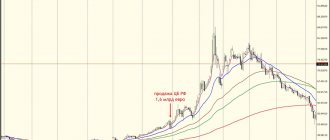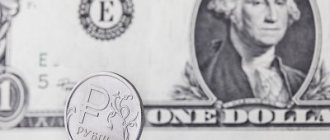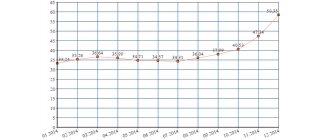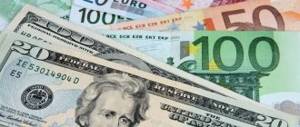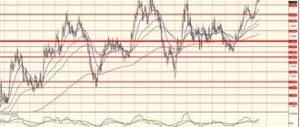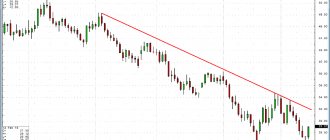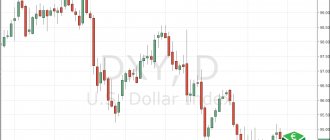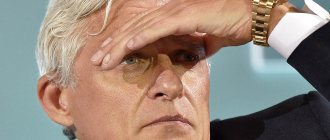The euro is becoming twice as expensive as the dollar: experts explained the reason
Since the beginning of June, the value of the dollar on domestic stock exchanges has increased from 68 to 74 rubles. Thus, in just two and a half months, the American currency increased in price by more than 8%. The euro rose in price twice as fast - its quotes increased over the same period by about 15%, increasing the cost of the “European” from 76 to 87 rubles.
The depreciation of the Russian currency was predetermined, experts interviewed by MK believe. Firstly, at the end of July, the Central Bank lowered the key rate to a record low of 4.25% (2% since the beginning of the year), which led to a drop in investor interest in ruble assets. “Against the backdrop of increased foreign policy risks, financiers prefer to sell Russian government bonds and exchange the proceeds in rubles for foreign currency, which puts pressure on the ruble,” says Dmitry Babin, an expert on the BCS Broker stock market. High foreign policy risks, including the November US presidential elections, also have a negative impact on the ruble exchange rate. “Anti-Russian rhetoric in the West is intensifying. Since the times of the USSR, relations between our countries have always deteriorated during the period of Democratic rule in Washington. Therefore, if Biden, who represents this particular party, wins, we can expect tougher economic sanctions against Russia,” the analyst notes.
Well, why is the euro becoming more expensive in Russia than the dollar? Strictly speaking, the fall in dollar quotations against the euro, or more precisely, its slow growth against the ruble, is to a greater extent not due to the influence of any Russian factors. American and European currencies have been waging a long-term war with each other, and their exchange rates rather reflect the state of affairs in the countries that print these banknotes. Most European experts associate the slowdown in the growth of green prices with the proposal of American senators to introduce a new package of measures to stimulate the domestic economy amid the spread of COVID-19. Its volume has not yet been approved: Republicans believe that $1 trillion will be enough, and Democrats insist on increasing subsidies to $3 trillion. The minimum payments for each US resident could be up to $1.2 thousand. In any case, Americans will have to resort to the services of a printing press again, which will negatively affect dollar quotes against the euro.
In turn, in the long-term and fierce struggle between the euro and the dollar for the right to be the main reserve currency of the world, Russian banknotes occupy the position of an outside observer. On the one hand, Russia was able to profit from the growth of the “European” exchange rate - this currency ranks first in the structure of our country’s gold and foreign exchange reserves, and its significant increase in price allowed us to bring domestic international foreign exchange reserves to a record level. On the other hand, the slowdown in the growth rate of the dollar is not a factor contributing to the strengthening of the ruble. “The value of the American currency, despite the failures against the euro, is still growing. Further dynamics of the ruble exchange rate will be closely related to fundamental factors, primarily with the demand for hydrocarbon raw materials, which has sharply decreased since the beginning of the year. A further drop in oil prices will mean a colossal decrease in export revenues for Russia, and specifically for the ruble - a devaluation that, at best, will not exceed 10%,” predicts Doctor of Economics Igor Nikolaev.
If Trump loses the presidential election, then by the end of the year the dollar could rise to 80 rubles. The European currency, which is now to a lesser extent fueled by internal political maneuvers, is capable of gaining even more points and growing to 95-100 rubles, which will once again prove the weak ability of the Russian financial system to repel foreign economic shocks.
When and how much will the US dollar fall in 2021, according to experts?
Over the past year, Russians’ attention has been focused not only on Covid-19, but also on the ruble exchange rate, which continued to fall amid general instability in the country and the strengthening of the dollar. And it is not at all surprising that on the eve of the new calendar year, many are wondering how the American currency will behave and whether it is worth preparing for the worst.
Last news
In recent days, the dollar exchange rate has been gradually declining, which gives reason for joy. So on December 23, trading on the Moscow Exchange ended with a positive result, since the dollar stopped at 75.78 rubles, which is 13 kopecks. lower than the previous day. For the first time in three weeks, the American currency began to fall, which gives an optimistic forecast for the ruble, which may strengthen its position by the end of the year.
Valery Emelyanov predicts that on Thursday-Friday the dollar exchange rate will fluctuate in the range of 74.5-75 rubles.
In 2021, the ruble to dollar exchange rate has turned into a real swing
Will the currency fall or rise in the near future?
If we talk about the fate of the dollar exchange rate in the near future, most analysts agree that it will continue to decline. Representatives of the FxPro company expect that over the next 30 days the US currency will drop to 72 rubles.
At the same time, in Libertex this indicator is at the level of 72.70 rubles, in Alpari – 71.69 rubles, and in InstaForex – 72.72 rubles.
Forecast 2021
Experts' forecast for 2021 is quite optimistic, since they expect a real depreciation of the dollar. By mid-summer it will be possible to see the value at the level of 70-72 rubles. per dollar, and if the pandemic subsides, then by the end of the year the figures will be even lower.
This is precisely the opinion shared by Sergey Grigoryan, head of the representative office of the State Interests Foundation of Armenia in Russia. According to data presented by analysts at the investment company FxPro, in 2021 the dollar will consolidate at around 72 rubles. for 1 USD.
Their colleagues from Libertex suggest that the dollar will fall to 67.75 rubles, which will be a truly joyful event for the entire past year. At the same time, financial experts Alpari and InstaForex suggest that the dollar will drop to 70.51 and 70.07 rubles.
Fortunately, expert forecasts are not so disappointing
Investments will not become more attractive
Minimum deposit rates provoked a massive outflow of Russians’ savings from banks. Keeping savings in financial institutions is no longer profitable: citizens are shifting to foreign currency, real estate, and even exploring the stock market to invest in securities.
Independent financial expert Dmitry Chechulin believes that the situation with interest on deposits will not change dramatically in 2021. Even if the Central Bank raises the key rate (and deposit rates directly depend on the size of the Central Bank’s key rate), it is unlikely to be sufficient to significantly improve conditions for deposits. The only option in which financial institutions can increase interest on deposits is through additional conditions for placing money. For example, storing more than 1 million rubles (remember, from January 1, such deposits will be taxed) or even more than 1.4 million rubles (this is the maximum amount of insurance compensation in the event of revocation of a bank’s license) or the mandatory purchase of an insurance policy.
In what cases may a bank not return money to a depositor? Five reasons Read more
Petrol
Fuel in Russia becomes more expensive every year (and regardless of oil prices).
“An increase in gasoline prices in 2021 is possible, especially if oil prices rise and the cost of a barrel breaks the $50 mark. <…> However, if the price of oil becomes cheaper, gasoline may also increase in price. We have seen this more than once. The fact is that oil companies are suffering large financial losses due to falling commodity prices and may try to compensate for them at the expense of consumers,” independent industrial expert Leonid Khazanov .
However, the expert does not expect a strong increase in fuel prices. The fact is that a significant rise in price can cause a blow to the economy and the population.
“In any case, the government is unlikely to allow this, so gasoline prices will rise by a maximum of 2-4%. I don’t yet see the prerequisites for more serious growth,” says Khazanov.
Main factors influencing the euro exchange rate
The single European currency (euro, EUR) is considered the direct and main competitor of the US dollar (USD) in the global market. That is why these monetary units are often in a certain opposition, thereby influencing each other’s positions. In Forex, for example, such interaction is carried out through the EURUSD currency pair (euro to US dollar).
If an investor is interested in purchasing any currency, this means that he is ready to invest his money in the economy of the country issuing this currency. Since both regions - the United States and the European Union - have powerful economic potential, the market rate of one currency (for example, EUR) changes due to the rise or fall of another monetary unit (for example, USD).
The market value of the euro is strongly influenced by the following key factors:
Price dynamics in the regional economy, inflation
To evaluate these indicators, the consumer price index
(abbreviated as CPI). The English designation is Consumer Price Index (abbreviated as CPI). The CPI indicator is determined separately for France, Germany and the entire Eurozone.
This index shows how the cost of specific goods (services, works) for consumers has changed. Based on this indicator, a conclusion is drawn about trends related to the volume of consumer purchases and current inflation in the country.
If the published CPI values of France, Germany and the Eurozone are higher than expected, the EUR usually rises to reflect the market reaction. If these indicators turn out to be lower than expected, this often leads to a weakening of the euro.
Investor confidence, economic sentiment
The main indicator is the Economic Sentiment Index
in Germany (in the original – ZEW Economic Sentiment). If the value of this indicator exceeds 0, this indicates positive, optimistic sentiment among institutional investors.
If it is below 0, this indicates negative, pessimistic moods. This indicator is considered important for the business environment of the European Union. An indicator value that turns out to be higher than expected often leads to an increase in the EUR. If the indicator turns out to be worse than predicted, the euro exchange rate decreases.
Monetary policy of the authorities
Market participants are interested in data on the interest rates set by the European Central Bank (ECB). The publication of this information is one of the most anticipated events for investors.
The release of information on rates is accompanied by a press conference by the head of the ECB - market participants are closely watching his speech. The speech of the head of the financial regulator is perceived as an indicator of trends that determine the further actions of the ECB regarding the euro exchange rate. An aggressive tone of speech may indicate a possible rate increase, and this, in turn, will contribute to the growth of the EUR.
The neutral nature of the speech suggests that the rate will not be changed in the near future. If you compare the ECB key rate with a similar indicator from the US Federal Reserve, you can predict the vector of dynamics for the EURUSD currency pair.
Economic growth indicator of the European Union (EU)
To reliably assess this indicator, investors analyze quarterly reports on the size and dynamics of GDP
(gross domestic product) of the eurozone. Relevant reporting is generated and published by Eurostat.
The release of these reports often leads to significant exchange rate fluctuations in the EUR on Forex. The biggest jumps usually occur when reported GDP figures are better than expected.
The state of the trade balance of the European region (Trade Balance)
Investors carefully analyze reports characterizing the trade balance of the eurozone. In addition, market participants are interested in the trade balances of the two largest economies of the European Union - Germany and France.
Trade Balance indicator
shows the import volumes and export volumes for the corresponding country, as well as the relationship between these flows. The value of exports characterizes the development of the eurozone.
The size of imports indicates the state of domestic demand in the region. To pay for goods and services exported from the EU, foreign buyers need euros. Accordingly, the volumes of such exports significantly affect the exchange rate dynamics of the EUR. If the Trade Balance indicators are higher than expected, the euro strengthens (if lower, the EUR falls).
Secondary factors affecting the euro exchange rate
The exchange rate of the single European currency (EUR) is also influenced by the following additional factors:
- Political situation in the region
. Like any other national currency, the euro is very sensitive to the factor of political instability. For example, threats to create internal economic coalitions (as an option, a union of Germany, France, Italy) have a negative impact on the market positions of the EUR. It should be noted that financial problems and political crises in the Russian Federation also contribute to the decline in the EURUSD exchange rate, since Germany invests a lot in the Russian economy. - Macroeconomic statistics for Germany
. The German economy is considered the largest in the European Union (EU). When analyzing its condition, experts and investors pay special attention to the gross national product (GNP, or GNP). In addition, inflation (CPI, or CPI), industrial production, and labor market indicators (for example, the unemployment rate) in Germany are assessed. The values of these indicators and their dynamics significantly affect the euro. - The budget deficit of each country belonging to the eurozone
. The budget deficit of a particular eurozone country (for example, France) can be a maximum of 3% of GNP (no more). This rule must be strictly observed by the participating countries. - Government obligations (called bonds) with a ten-year maturity
. The difference between the interest rates of the European Union and the United States is considered as a serious factor determining the exchange rate of the EURUSD currency pair. For the EU, Germany's ten-year bonds are considered the standard. If the rate on German government bonds is less than the rate on ten-year US Treasuries, then an increase in the number of German securities (or a decrease in the number of American securities) will strengthen the position of the euro. - Interest rate for a three-month Eurodeposit
. We are talking about the profitability of a deposit placed in EUR currency in financial institutions outside the eurozone. This deposit is considered the standard for calculating the difference in interest rates when determining the exchange rate. For example, if the euribor rate is significantly higher than the EURUSD deposit rate, then the EURUSD rate may increase. However, the reliability of this indicator still raises some doubts. - The influence of cross rates on the foreign exchange market
. EURUSD exchange rate dynamics may depend on the movement of cross-currency pairs (these are pairs without USD). Typical examples are EURJPY, EURCHF. So, if important economic news comes out in Japan that strengthens the yen (JPY), then a fall in EURJPY may lead to a weakening of the EURUSD pair. - The effect of a negative correlation
existing in the foreign exchange market between the EURUSD instrument and the USDCHF pair. Essentially, this correlation reflects the relationship between the euro (EUR) and the Swiss franc (CHF). This pattern is clearly observed today, given the fact that Switzerland is increasingly dependent on the eurozone economy. Often, a fall in EURUSD (euro against the dollar) leads to a decrease in EURCHF quotes. In crisis situations, however, this correlation may not work.
In addition, the EUR exchange rate may significantly depend on forecasts and analytical reviews published by influential participants in the financial market - the largest banks, leading investment funds, popular experts.
Practice shows that the euro is very sensitive to such publications, and the reliability of forecasts does not affect the market reaction.
